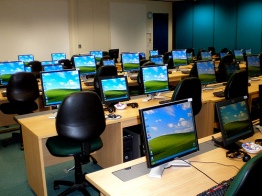At the last meeting of our school division’s Learning and Technology Committee we focused our discussions on information literacy. We read through the new standards and the learning attributes of our 21st Century learners in an endeavour to ascribe our own understanding and meaning to the term, information literacy. The teachers articulated the concept in the following ways:
- Information literacy is open, connected, collaborative, social, flexible/adaptive, critically, ongoing and inquiry-based.
- Creating media literate students who retrieve and think critically about information from several sources and merge into a relevant and succinct format using collaboration.
- To be technologically literate the students must be motivated to sail the 7 C’s and be connected, constructive, critical, collaborative, comfortable, creative and courageous.
- Information literacy is the way you deal with information that is presented to you, the definition has changed in the past year, month, day, hour. To be info literate you must be able to recreate meaning through collaboration using critically thinking skills.
- The ability to process, evaluate, re-evaluate and network information within a global community.
- Actively be able to find information, critically assess and internalize in an ever-changing environment.
Determining what our students require at different grade levels to meet this understanding of information literacy was much more difficult.
We began to work with a brief document that I had created with teachers in a K – 8 school. We had based our discussions around the revised NETS and created a one page document that focused on specific areas for each grade level:
- Pre-K – Kindergarten: Basic computer use and access
- Grade One, Two and Three: Online connecting, communicating and collaborating
- Grade Four and Five: Productivity Tools and Digital Storytelling
- Grade Six, Seven and Eight: The Architecture and Grammar of the Internet
- Grades Nine – Twelve – Design

Even with a basic document as a guide teachers struggled to identify at what grade level specific skills should be taught. They still wanted a scope and sequence. I heard it from almost every group. Why is this so? I believe that in many ways it is due to an instructional practice of the late 20th century – a computer teacher based in a computer lab. This setting and instructional approach maintain the belief that computers and technology must be taught rather than used to teach and learn and therefore require a curriculum.
After this experience, which reinforced the principles in the reading that I have done on information literacy, I believe that we do an injustice to our students by categorizing and assigning a grade level to technology and information literacy skills. Instead we should ask, “what thinking skills do our students require to successfully cope in a world of overwhelming and constantly changing information?” These are skills that cross all grade levels but are taught in developmentally appropriate ways.
Following this meeting I had a brief introduction to the new Saskatchewan ELA curriculum K- 9 which has inquiry embedded within it. Entrenched in inquiry learning are the skills that students need to find, use and share information. Maybe I am being somewhat optimistic but I believe that this is what will ensure that all students are taught how to use information effectively – which in the 21st Century involves the use of technology. It is now the responsibility of all teachers, not the teacher-librarian and not the computer teacher, to ensure that their students are taught, practice and master the skills for an information rich 21st Century.
I would hope as the writers of the New Literacy wiki state, “that the skills of using technology become the habits of students and teachers – that technology is called upon when needed the same way a dictionary or pencil has been in the past. Search techniques or spreadsheet skills, for example, should be learned when they are needed, not only age appropriately, but also context appropriately. Technology skills will be learned in school by students in the same way it is learned “in the real world”: as they need it.”
The next meeting of the Learning and Technology committee will be to examine new trends in professional development. We will take another look at information literacy and the implications of the inquiry strand in the new ELA curriculum. But, perhaps instead of a focus on the creation of technology and information literacy skills continuums, we will discuss how we can support our classroom teachers to ensure that information and technology skills are a part of all their classroom activities.
Photo: Clifton’s Computer Lab
http://flickr.com/photos/rexlibris/
 page,
page, 





